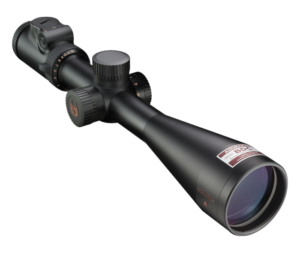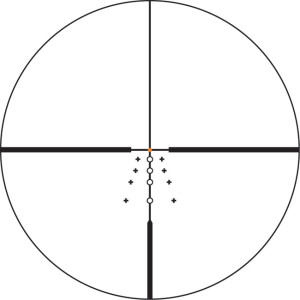“Today’s refined rifleman demands modern reticles featuring holdovers for elevation, wider magnification ranges, improved optical systems, better lens coatings, improved turret designs and illuminated reticles. Many modern riflemen embrace whatever practical technology can give them an edge.
 One manufacturer to recognize this trend is Nikon Sport Optics. It has been shaking things up lately with its recently introduced front-focal plane reticles on the Monarch 3 line. These are the first such reticles offered by Nikon, and while these new Monarch 3 scopes will appeal to many, I was frankly more impressed by Nikon’s new flagship Monarch 7 line of hunting scopes.
One manufacturer to recognize this trend is Nikon Sport Optics. It has been shaking things up lately with its recently introduced front-focal plane reticles on the Monarch 3 line. These are the first such reticles offered by Nikon, and while these new Monarch 3 scopes will appeal to many, I was frankly more impressed by Nikon’s new flagship Monarch 7 line of hunting scopes.
The Monarch 7 was designed for the American rifleman looking for an upper-crust scope, but who didn’t want mil/metric adjustments or a reticle out of a video game. While this scope is packed with features, it doesn’t require a 10-pound manual to explain the reticle. Plus, it doesn’t force you to think in mils or centimeters as it features traditional MOA adjustments.
Nikon currently offers five models in the Monarch 7 line:
- 2.5-10x50mm Advanced BDC
- 3-12x56mm Advanced BDC
- 3-12x56mm IL Advanced BDC
- 4-16x56mm Advanced BDC
- 4-16x56mm IL Advanced BDC
The sample I tested was the 3-12x56mm IL Advanced BDC with Dot. The 3-12X magnification range and large 56mm objective is a traditional European style. Built on a 30mm tube, it has pleasing lines and is an attractive optical device. But what does it actually bring to the table?
It is 14.3 inches long, but even with that fat 56mm objective, it weighs in at only 25.8 ounces. So it’s not overly rotund and is considerably lighter than models built on 34mm tubes. Nikon’s low-profile finger-adjustable turrets feature precise audible and tactile 1/4 m.o.a. adjustments. One full revolution  provides an impressive 24 m.o.a. of adjustment with 78 m.o.a. available. The turrets are clearly marked, and full turret revolution lines allow you to easily keep track of how much elevation/windage you’ve dialed in.
provides an impressive 24 m.o.a. of adjustment with 78 m.o.a. available. The turrets are clearly marked, and full turret revolution lines allow you to easily keep track of how much elevation/windage you’ve dialed in.
What I love about this turret system is how easy it is to zero compared to traditional European turrets, which are typically a pain to zero and require a fine screwdriver. Nikon’s Spring-Loaded Instant Zero-Reset design requires no tools and is hassle-free. You simply pull up the knob until it moves freely, adjust to zero and release. It’s that fast and easy.
On the left side of the mechanism block is a side-focus knob. This allows parallax to be eliminated and is more conveniently placed than a traditional adjustable objective. Pull it straight out to unlock it and then rotate it to the desired position. Pushing it back in locks it in place so it cannot be accidentally rotated. This is a useful feature, especially for hunting.
Unlike most of its competition, the Monarch 7’s illumination system does not feature a conventional rheostat located on the mechanism block. Instead, Nikon incorporates a microprocessor-controlled illumination system above the eyepiece. A button on the left side decreases intensity while one on the right increases it. A center aiming dot, rather than the entire reticle, is illuminated. Intensity is bright enough, when turned all the way up, to clearly see it in bright daylight.
Nikon’s Advanced BDC reticle is located in the second focal plane and consists of a crosshair with center dot plus four circles below it on the lower vertical stadia. These provide hold-over points to compensate for bullet drop out to medium range. On either side of each circle are + marks for windage or lead. These + marks are intended to be reference points to roughly indicate windage holds for a 10mph wind.
The circles feature an inside diameter of 1.5 m.o.a. and an outside diameter of 2 m.o.a. They offer 2, 4.5, 7 and 11 m.o.a. of compensation while the top of the vertical post provides 15 m.o.a. If you know the drop of your load, you can easily plot your trajectory in relation to Nikon’s BDC reticle. Roughly, the reticle will provide aiming points from 100 to 500 or so yards for standard velocity cartridges and out to 600 or so yards for magnums.
But what if you don’t know your load’s trajectory? Or perhaps you’d like to compare different loads? No problem. Nikon developed a ballistic software program called Spot On. Simply go to NikonSportOptics.com, click on Products, then Hunting to find the Spot On page. It’s very easy to use, allows you to print out custom hold-over/windage charts for whatever magnification you desire, and best of all, it’s free.
It took me about a minute to log into Spot On, figure it out and print a custom hold-over chart for my caliber and load of choice for both 6X and 12X. You can even get an app for your mobile device to take it with you to the range. So Nikon has made things fairly easy regarding bullet drop and windage.
Magnification features a fourfold increase, and I’m a fan of the 3-12X magnification range for field use because I’ve found it to be practical. When set on 3X the Nikon provides a wide field of view (39.4 feet at 100 yards), a huge exit pupil and a forgiving eye box. This makes it well suited for rapid snap shots at moving targets.
Crank it up to 12X and you have sufficient magnification for most types of hunting and field shooting. Plus, there isn’t so much magnification that mirage becomes a huge issue. A few days ago I was shooting out to 1,100 yards in Colorado, and the August mirage was so bad it limited you to about 10X to 12X. Where this scope really shines, though, is in dusk and low-light scenarios. Set on 10X it still generates a whopping 5.6mm exit pupil.
Optically, the Monarch 7 performed extremely well. Color rendition is quite accurate. Resolution is very good, and the image is sharp and clean to the edges. I compared it side by side to a Steiner 5-25x56mm T5Xi with both set on 12X, and the Nikon stood toe-to-toe despite costing half as much.
The eye relief is fairly long and the fast focus eyepiece works well. The scope features an attractive satin black finish with gold markings. It’s waterproof/fogproof and features Nikon’s Ultra ClearCoat lens coating system. As expected, all lens surfaces are fully multicoated.
I did experience one problem during testing: I was not able to dial out parallax at close distances, namely 50 yards. This was not an issue at 100 yards and beyond, but something I noted during testing.
To be frank, riflemen who loathe BDC reticles will not like this scope. Neither will those who prefer mil reticles and mil adjustments. Understood. But if you prefer m.o.a. adjustments, second focal plane reticles and easy-to-understand reticle designs, this is a scope line worth a look. At $1,100 it’s not inexpensive, but it does offer a lot of performance for the money.
Read The Original Article Here
My thoughts:
I’ve always been a fan of the Nikon Monarch series of scopes and believed that they were a good value for the money. However, I have one major and ongoing issue with the Monarch series, and the author actually mentioned it in the piece above. My issue is the parallax range on the Monarch and the fact that it bottoms out at 50 yards. It should be noted that this 50-yard parallax limit isn’t just an issue on the Monarch series; it’s also an issue on most all the other Nikon scope lines, with the exception of their rimfire EFR line.
So what’s my issue with the parallax only going down 50 yards? From a target and long-range shooting perspective, it’s not an issue at all. However, from a hunting perspective, it’s an issue for me. I can’t count the number of times that I’ve had whitetail deer show up and ranges under the 50-yard mark. With the parallax bottoming out at 50 yards, any target under the 50-yard mark is blurry and out of focus, even with the scope set on the lowest power setting. Trust me when I say that trying to locate the shoulder of a nice whitetail through a blurry scope is much harder than it sounds. Now I’m no engineer nor do I work on the design side of the rifle scope industry, but if other scope brands like Sightron and Weaver can integrate parallax settings that focus below the 50-yard range, then a quality line like Nikon should be able to do that as well (at least IMHO).
My other issue with the Monarch series is minor but it bears mentioning. Currently, the Monarch series is offered in a Monarch 3, Monarch 5, and Monarch 7 series and the MSRP and street price goes up for each series, with the 7 being the most expensive of the Monarch line. From the consumer standpoint, you would expect that as you move “up” in the series numerically and cost-wise, the quality of the glass would go up as well.
However, I’m not so sure that’s the case. I have a Monarch 3 in the 6-24X50 SF version, and a shooting partner has the Monarch 5 in the same configuration, but with a different reticle. Now he paid more for his 5 than I did for my 3 and both were purchased new in box.
However, shooting over both scopes side by side, I cannot tell any difference in glass quality. As a matter of fact, my Monarch 3 might be just a hair clearer edge to edge at 24 power compared to his 5. Now it could be that the glass difference between the two series is really minuscule, but I sure can’t tell a difference.
All that being said, I’m still a fan of the Monarch series (in spite of the 50-yard aluminum parallax issue) and think they offer a good value for the money. Plus, Nikon offers an excellent warranty and stands behind its products.
Update – Since the review above was originally published, Nikon Sport Optics opted to stop producing scopes at the end of 2019.
Here are the best deals I could find on the Nikon Monarch line of scopes in various power ranges: